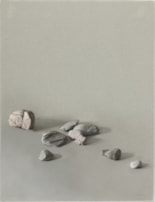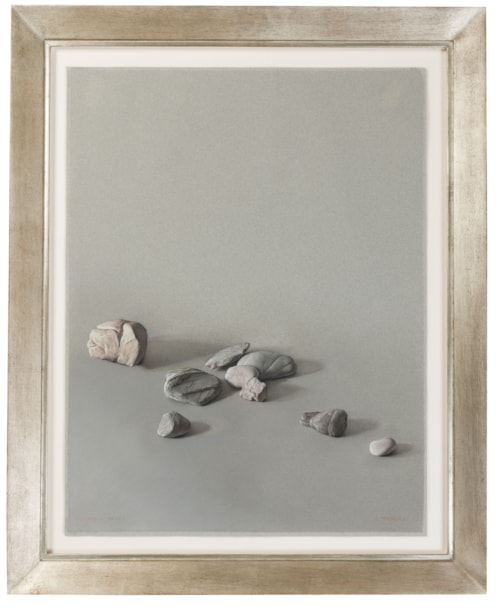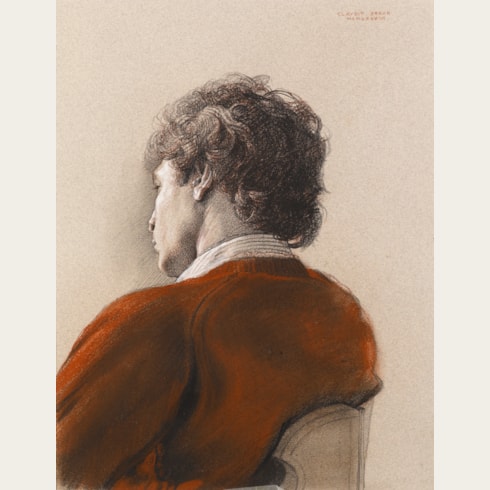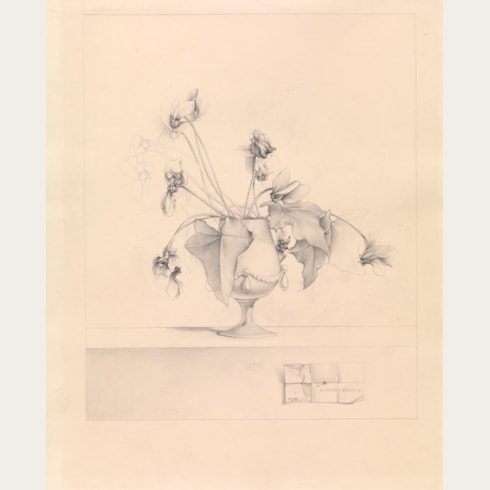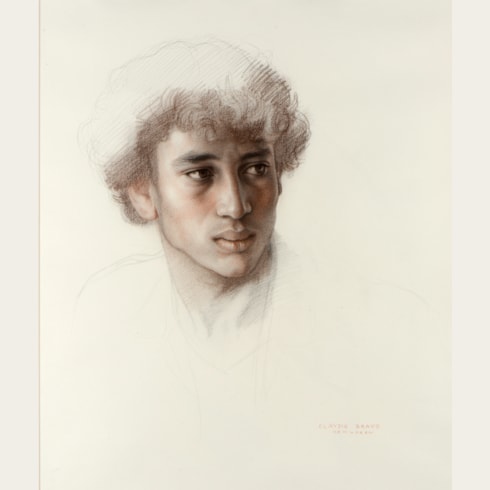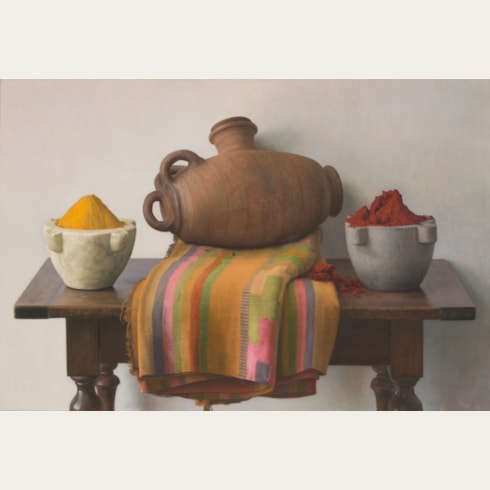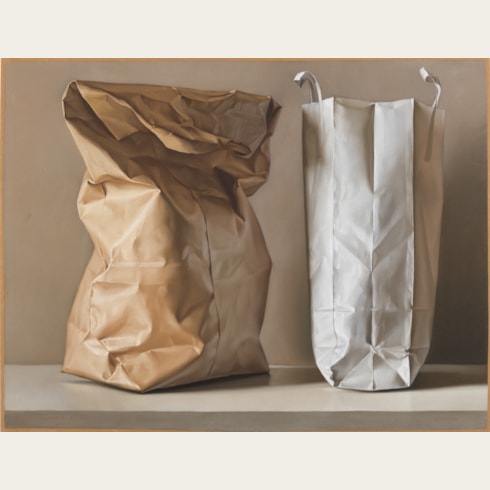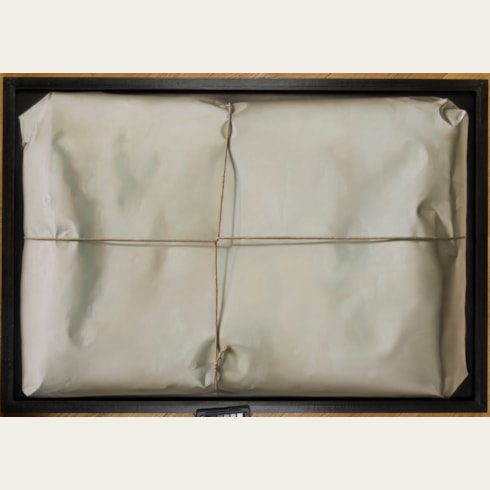Claudio BRAVO
(Valparaiso 1936 - Taroudant 2011)
Untitled (Stones)
Sold
Pastel on blue-grey paper.
Signed CLAUDIO BRAVO in red chalk at the lower left and dated MCMLXXI in red chalk at the lower right.
640 x 488 mm. (25 1/4 x 19 1/8 in.) [image]
650 x 499 mm. (25 5/8 x 19 5/8 in.) [sheet
Signed CLAUDIO BRAVO in red chalk at the lower left and dated MCMLXXI in red chalk at the lower right.
640 x 488 mm. (25 1/4 x 19 1/8 in.) [image]
650 x 499 mm. (25 5/8 x 19 5/8 in.) [sheet
This large pastel, drawn in 1971, can be grouped with a number of paintings, watercolours and pastels of stones executed by Claudio Bravo in the early 1970s, while he was living and working in Madrid. As one writer has noted of these works, ‘In another series of still lifes one can find…references to Dada and Surrealist art. In the numerous paintings of stones on which Bravo worked in the early 1970’s, there are reminiscences of Jean Arp’s chance arrangements of objects as well as an even stronger visual relationship to many works by Yves Tanguy. This is true not only in so far as the objects themselves are concerned (the stones resemble the ectoplasmic blobs painted by many of the Surrealists) but also of the vague, amorphous desert-like space in which they rest. Another source for the stone paintings is Zen philosophy in which the artist was intensely interested throughout the 1970’s. In his readings in the processes of Zen meditation, Bravo was struck by passages describing meditation on stones thrown at random onto a surface. Each time they are thrown, they will take on a different configuration. They will also look completely different in their patterns when thrown by different people.’ As the artist himself was later to recall, ‘I experimented with Zen ideas in my own work then and did a group of paintings of stones thrown at random on a table.’
Two comparable small watercolours of stones, both dated 1971, are illustrated in a 1985 monograph on Bravo.
Two comparable small watercolours of stones, both dated 1971, are illustrated in a 1985 monograph on Bravo.
Born in Valparaiso in Chile, Claudio Bravo received a Jesuit education in Santiago and there took art classes in the studio of the painter Miguel Venegas Cienfuentes, eventually deciding to become an artist himself. He had his first exhibition at the age of seventeen, and was soon much in demand as a portrait painter. In 1961, after several years living and working in Santiago and Concepción, Bravo left Chile for Europe. Settling in Madrid, he established a very successful career as a painter and society portraitist. In 1968 he spent six months working in the Philippines, and in 1970 had his first solo exhibition in New York. In 1972 he abandoned his busy life in Madrid for a large house and studio in Tangier in Morocco, where he began to focus on still life and landscape painting. Dividing his year between his studio in Tangier and another in Marrakech, as well as one in the far south of Chile, Bravo enjoyed a successful career until the end of his life. As one scholar noted, at the time of an exhibition of his work which toured four American museums in 1987 and 1988, ‘Claudio Bravo is one of the most significant artists working in a realist mode today. A painter and draftsman with a singularly fertile imagination, Bravo draws upon a myriad of sources in the art of the past and present, combining them in a uniquely personal manner.’
In 1994 a large exhibition of Bravo's paintings was mounted at the Museo Nacional de Bellas Artes in Santiago, Chile. Works by Claudio Bravo are in the collections of the Baltimore Museum of Art, the Ludwig Museum in Cologne, the Metropolitan Museum of Art and the Museum of Modern Art in New York, the Philadelphia Museum of Art, the Princeton University Art Museum, the Museum Boijmans-van Beuningen in Rotterdam, the Museo Nacional de Bellas Artes in Santiago and elsewhere.
Long recognized as a superb draughtsman, Bravo was a master of pencil, coloured chalks and pastel, which he applied with precision and delicacy.
Provenance
Galería Egam, Madrid, in 1971
Acquired from them by a private collection, Europe
Anonymous sale (‘Property of a European Collector’), New York, Christie’s, 20 November, 2007, lot 197
Private collection, New England.
Acquired from them by a private collection, Europe
Anonymous sale (‘Property of a European Collector’), New York, Christie’s, 20 November, 2007, lot 197
Private collection, New England.
Literature
Paul Bowles, Francisco Calvo Serraller and Edward J. Sullivan, Claudio Bravo: Paintings and Drawings (1964/2004), Madrid and New York, 2005, illustrated p.24.


